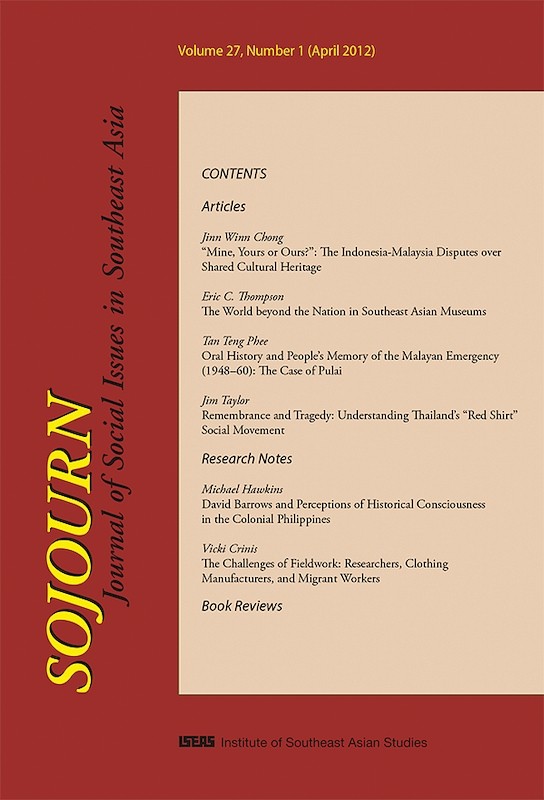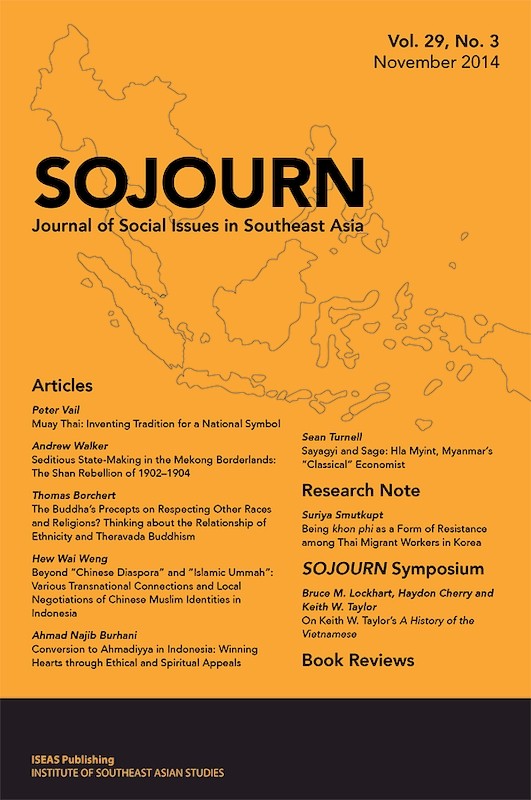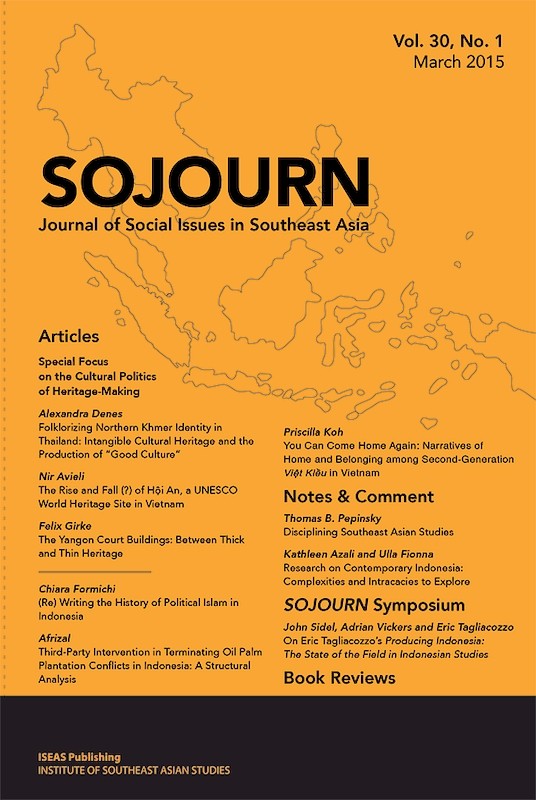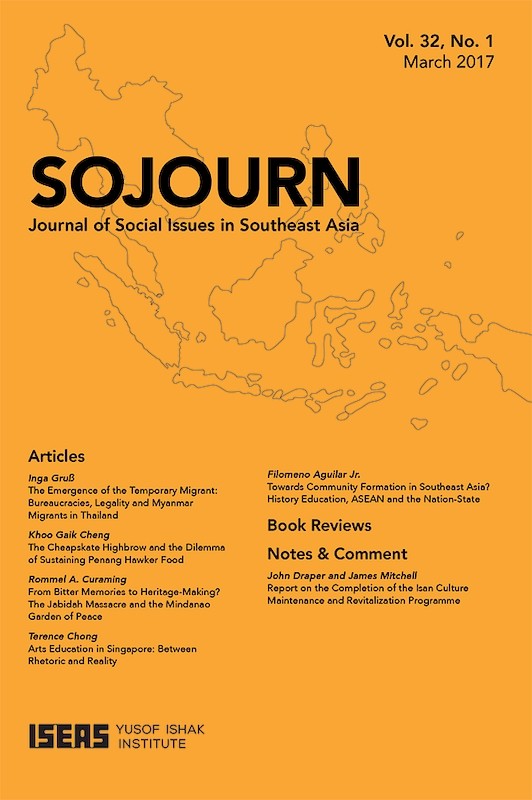SOJOURN: Journal of Social Issues in Southeast Asia Vol. 27/1 (April 2012)

Date of publication:
April 2012
Publisher:
Institute of Southeast Asian Studies
Number of pages:
204
Code:
SJ27/1
Contents
-
SOJOURN: Journal of Social Issues in Southeast Asia Vol. 27/1 (April 2012)
[Whole Publication, ISSN: 17932858] -
Preliminary pages
- ARTICLES
-
"Mine, Yours or Ours?": The Indonesia-Malaysia Disputes over Shared Cultural Heritage, by Jinn Winn Chong, author see abstractAs regional neighbours, Indonesia and Malaysia share common historical roots and cultural heritage. Disputes over cultural icons have lamentably been a frequent affair between the two countries. One of these recurring clashes was recently brought to the fore when a third party erroneously represented an Indonesian traditional dance as Malaysian. Based on this episode, this article analyses the multifaceted complexities embedded in disputes involving contested cultural heritage. It underscores the point that quarrels over ostensibly petty issues are often symptomatic of protracted undercurrents of political conflict between states. Drawing from the illustrations of the pendet example, it further demonstrates how failure to address these latent tensions could potentially result in destructive manifestations, even over seemingly trivial spats. By way of conclusion, the article proposes that examining these disputes within the broader context of the history and dynamics of the relationships of the various parties of the dispute becomes necessary and critical in engendering a sustainable resolution of disputes over shared cultural heritage.
-
The World beyond the Nation in Southeast Asian Museums, by Eric C Thompson, author see abstractNational museums are exemplary sites through which nations tell their story and represent themselves to their citizens and others. The national museum has replaced the colonial museum identified by Anderson in Imagined Communities, as a modern technology and form of communication through which national communities are brought into being. Yet national museums tell other stories as well. In this article, I examine how national museums represent the world beyond the nation. Based on an examination of twelve national or national-type museums in seven Southeast Asian countries, I argue that national museums produce representations of the world beyond the nation and specifically of Southeast Asia that enframe and produce the geo-body of the nation state while simultaneously creating particular imaginaries of the world beyond, including a common use of contemporary Southeast Asia as a regional enframing device. While all national museums frame the nation in reference to the world beyond, they do so in significantly different ways with implications for the international and regional orientations of citizens of Southeast Asia.
-
Oral History and Peoples Memory of the Malayan Emergency (1948-60): The Case of Pulai, by Tan Teng Phee, author see abstractBy using the oral history approach, this article challenges the state-oriented discourse on the success of the Malayan Emergency. The British colonial government made claims that a "New Village" was a safe haven providing sanctuary, security, and a modern way of life for "alien Chinese squatters". In contrast to state interpretations, what emerges from the oral recollections of the elderly residents of Pulai contradicts much of the official narratives which mostly highlight success stories. Based on interviews with seventeen individuals affected by the resettlement programme targeted at the Pulai people, this article aims to represent their hidden history and the legacy of their difficult past. While on the one hand, the article demonstrates the breadth and depth of state intrusion and its effects on ordinary lives and the vulnerability of ordinary people caught between hostile opponents, on the other, the most striking finding of this research is the resilience of the Pulai people themselves - a resilience that was especially evident during the Emergency rule that can only be recaptured through oral history recording because of the absence of archival material, both state as well as national.
-
Remembrance and Tragedy: Understanding Thailand's "Red Shirt" Social Movement, by Jim Taylor, author see abstractThis is a reflection on the Red Shirt social movement in Thailand based on ethnographic research conducted in 200711. Under its umbrella organization, the National United Front for Democracy Against Dictatorship, the social movement generated a momentum never before seen in Thailand following the consequences of the 19 September 2006 coup dtat. The resistance and mass calls for democratic change came from the periphery, not the centre as in previous modern protests staged in the metropolis. At an ideological level, the movement is differentiated but united in its understanding of the conditions of modern history and the complexity of centre-summit dominance. Red Shirts have been engaged in an ongoing struggle against a social and political adversary with the overall objective, yet to be achieved, of bringing about broad democratic institutional changes at all levels. Taking to the barricades in April-May 2010, which led to the killing of many protestors, was a last resort for the masses frustrated by the distortion of history and obstruction of societal changes under the self-serving interests of the ruling royalists. How will this tragedy of recent times be narrated in standard histories is debatable, as a memory of the past, conscious or unconscious, is conditioned by the experience of the present. But at specific sites of memory (lieux de mmoire), there will be continuing conversations and, undoubtedly, little forgetting among the masses.
- RESEARCH NOTES
-
David Barrows and Perceptions of Historical Consciousness in the Colonial Philippines, by Michael Hawkins, author see abstractThis article explores American efforts in the colonial Philippines to instil a consciousness of history and modernity among Filipinos through a carefully crafted philosophy of time. It focuses primarily on David Barrow's work, History of the Philippine Islands (1905), as the ideal embodiment of a broad discourse permeating notions of superiority and inferiority, historicity and ahistoricity, and civilizational development - notions which shaped colonialism in the Philippines. This article argues that Americans were able to develop a sense of fundamental temporal difference with their colonial subjects - a fundamental difference that could be effectively employed and articulated to overcome shortcomings or inconsistencies in other discourses of colonial power.
-
The Challenges of Fieldwork: Researchers, Clothing Manufacturers, and Migrant Workers, by Vicki Crinis, author see abstractThis paper highlights the unique challenges faced by researchers conducting a multi-sited study of the clothing industry in Malaysia. The study involves workers and manufacturers in multiple sites in industrial suburbs across Malaysia. The workers in the study, mostly female migrant workers, are considered to be a vulnerable group because they are subjected to harsh discipline under company contract conditions and state immigration laws, as well as difficulties faced within an industrial urban environment. Feminist principles were adopted in the multi-sited ethnography with the aim of facilitating connections among different subjects and a more equal and caring relationship between ethnographer and the subjects being researched. Stacey (1988) asserts that generic ethnographic research should follow feminist methodological principles such as egalitarianism, reciprocity, and reflectivity, although simultaneously she argues that the closer the relationship between ethnographer and subjects, the greater the likelihood of exploitation. In the case of the author's research, applying feminist principles was for the most part successful although it was difficult to develop close personal relationships with the migrant workers studied because of the multiplicity of sites, the difficulties in locating a migrant worker community, coupled with the short time workers spent away from the factory. In terms of the manufacturers interviewed in this study, the author developed relationships of trust with some, but maintaining trust and transparency with others within a corporatist network of manufacturers became more challenging as the fieldwork progressed. Moreover, the paper raises some of the tensions specific to feminist principles and some relevant to "multi-sited" ethnographic research.
- BOOK REVIEWS
-
BOOK REVIEW: Materializing Exile: Material Culture and Embodied Experiences among Karenni Refugees in Thailand, by Sandra Dudley, by Amporn Jirattikorn, author
-
BOOK REVIEW: Christianity and the State in Asia: Complicity and Conflict, edited by Julius Bautista and Francis Khek Gee Lim, by Seng-Guan Yeoh, author
-
BOOK REVIEW: Islam and Popular Culture in Indonesia and Malaysia, edited by Andrew Weintraub, by Sven Alexander Schottman, author
-
BOOK REVIEW: Dangdut Stories: A Social and Musical History of Indonesia's Most Popular Music, by Andrew N. Weintraub, by Adil Johan, author






